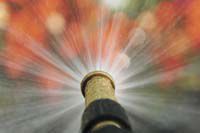Even though Carbon County experienced a long and wet winter season, water conservation is still an issue of importance in Carbon’s dry climate for several reasons.
Utah is one of the five fastest growing states in the nation and it shares a border with four other fastest growing states.
From 1990 to 2000, Utah’s population increased by more than 510,000 people, just over 2.2 million. To put it another way, Utah’s semi-arid terrain is sprouting another city approximately the size of Salt Lake City about every three years.
Although Carbon County’s population has maintained relative stability, the Goosebury Dam issue is still up in the air and local water issues remain as pressing as ever.
According to the Governor’s Office of Planning and Budget, Utah’s rapid growth will continue, with the population more than doubling to nearly 5 million by 2050. As Utah’s population blossoms, so will the demand for Utah’s limited water resources. If Utah’s municipal and industrial water demands increase at the same rate as its population growth, the state is headed for trouble.
Both state and local officials have outlined several ways for local residents to conserve water while still beautifying their property.
In order to assist citizens in identifying water wise plants for our region, the state has developed a program to recognize desirable low water use species. Representatives from several government and local organizations have worked together to organize a list of ornamental trees, shrubs, herbaceous perennials, ornamental grasses and ground covers that meet the criteria below:
Plants are
•Water wise.
•Adapted to Utah’s arid climate and cold winters.
•Available in the industry.
•Relatively easy to maintain in the landscape.
•Have desirable landscape characteristics which remain desirable under limited water availability.
The water wise designation means that a plant needs to be watered at most once every two weeks, after establishment and will still retain its aesthetic characteristics.
A generic, bright yellow tag or label with a recognizable logo will show the consumer that what they are looking at is a water wise plant.
“Look for this tag at participating nurseries and garden centers throughout the state, and you will know you are purchasing a recommended plant, it’s as easy as that,” states the Utah site at www.utah.gov.
Additionally, state officials have instituted a water check to analyze the efficiency of an individual’s sprinkler system.
“A horticulture intern will perform the water check at your home and provide you with a customized water schedule,” says www.slowtheflow.org. “The tests that will be performed include soil type, grass root depth, sprinkler distribution uniformity and water pressure. The entire process will take approximately an hour.”
Water checks are a free service and are available from June through August.
A typical lawn has a water demand curve that begins in mid-April, rises to a peak in July, and then falls rapidly until mid-October. Adjusting the timer monthly to better follow this demand curve will save water and funds.
“An easy way to do this is keep the minutes constant and increase or decrease the number of days between watering,” says the Utah Division of Water Resource Board’s website.
Starting with 21 minutes every four days in May and increasing to 27 minutes every three days in July and August. From that point the water schedule falls off to 27 minutes every five days by September.
Furthermore, Utah State University detailed several suggestions for saving water within the home.
To save water in the bathroom:
•Check the toilet for leaks by taking off the toilet tank and cover and then adding 10 drops of food coloring to the water in the tank. Wait 15 minutes, then check for color in the toilet bowl. Any color in the bowl indicates a leak, which should be fixed immediately.
•Check the water level in the toilet tank, the fill line in the tank should be about a half inch below the overflow tube. Water spilling over this line can waste hundreds of gallons each day.
•Place a two liter filled bottle in the toilet tank. This will reduce the amount of water used each time the toilet is flused. This saves about a half gallon per flush on any toilet.
•Don’t use the toilet as a wastebasket. Drop tissues and other trash in the wastebasket and save the water that would be used with each flush. Each flush of a standard toilet uses 3 and a half gallons to 7 gallons.
•Turn off the water when brushing. Wet the brush and then turn off the water while brushing ones teeth. Rinse briefly when finished. This saves over nine gallons of water each brushing.
•Take shorter showers or take a bath if a long soak is desired. Shorter showers save not only water but energy. A 10 minute shower can use upwards of 70 gallons of water, where as a full tub uses only 20.
For a full list of water conservancy tips visit the Division of Water Resources at www.utah.gov.
Carbon residents cautioned, use prudent water practices

